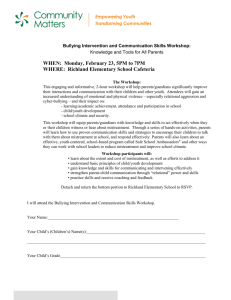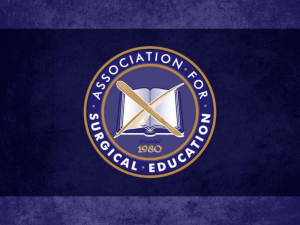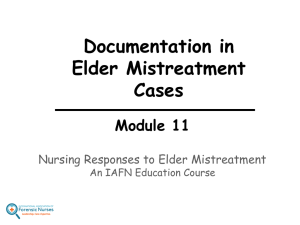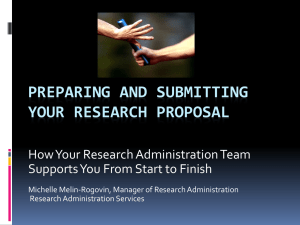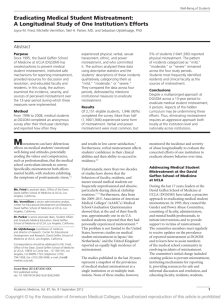OSR National Meeting - University Medical Student Council
advertisement
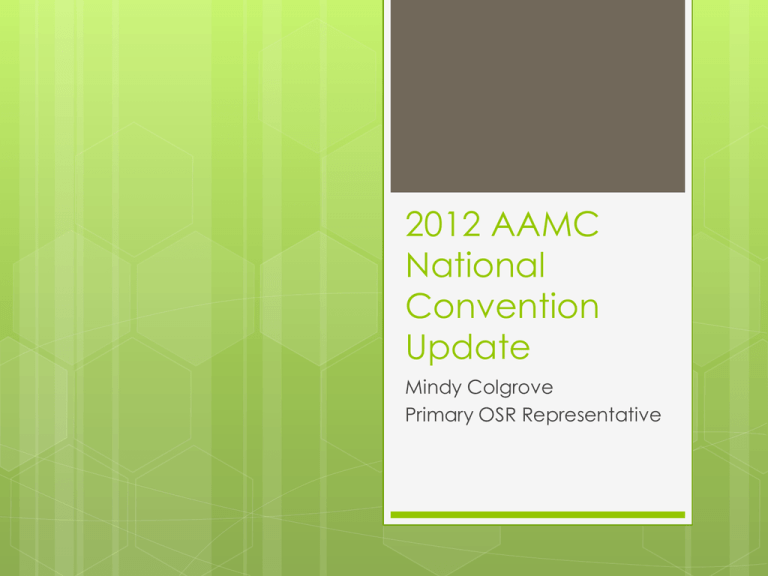
2012 AAMC National Convention Update Mindy Colgrove Primary OSR Representative Student-Raised Issues Wellness Diversity Reporting mistreatment in medical education Sharing standardized high-quality lectures across campuses Increasing financial debt and how students handle their financial debt OSR’s role in LCME accreditation for each school OSR Sessions Thoughtful Points Many students don’t understand that Medicare helps fund residencies so cutting the Medicare budget cuts the residency budget as well. When you sign up for the role of a physician you automatically sign up to be a role model and a leader even if you don’t want to be one. We are born patients and will die patients. Look at things from the patient’s perspective. Important Issues Anonymous reporting by staff and peers on poor professionalism is important GRMC meetings: AAMC group which deals with regional campus issues 92 regional campuses in the US and 14 in Canada >50% of medical schools have a regional campus 1st ever OSR liaison on the GRMC committee currently; he takes student concerns about regional campus issues to the AAMC directly Breakout Session Social media: If you don’t make your own online presence, someone else will do it for you and it may not be good. Put out correct information about who you are rather than having to change your Facebook name during residency application dates. Honor the Humanism In Medicine Award nominees locally to guarantee they are recognized for their achievements. Methods At Other Schools Changes to curriculum grading: School surveys sent to recent grads/interns for their opinions on grading because they interact with people trained at other schools and have their skills tested Mistreatment reporting: Committee reviews anonymous complaints Hotline pager or answering machine Discuss examples at student orientation (i.e. pimping to the point of public humiliation) Fine faculty like athletes based on the number/severity of complaints Is the aftermath/backlash a deterrent to student reporting? We all have a duty to report observed mistreatment Poster Session Baylor College of Medicine – Baylor Community Service Day: 5-6 hours of service in the community on the Saturday of orientation for M1s Cleveland Clinic Lerner College of Medicine of Case Western Reserve University – Cleveland Clinic Lerner College of Medicine's Capstone Experience: 2 weeks around match day, ACLS accreditation over 2 days, review of some important basic science and condition management info necessary for intern year Eastern Virginia Medical School – Anatomy Guy: Engaging the World by Engaging Students and Faculty in Vertically Integrated Medical Curriculum for the Web Indiana University School of Medicine – Indiana University Simulation Integration Rubric (IUSIR): interprofessional simulation with nursing and medical students, 2 years on the same team, learn each other’s role and how to interact with each other on cases via simulation Texas A&M Health Sciences Center College of Medicine – OSR Role During LCME Preparation and Site Visit: have the faculty speak to the students about what they need the students to know and do, have OSR organize PowerPoint presentations and really inform the students, OSR should serve as the point person between the faculty and the students for explaining things to the students and organizing the students to cooperate and help the school, avoid sending tons of emails University of Mississippi School of Medicine – Designing a Medical School Capstone Course: a couple weeks during the 4th year, transition to intern year with topics like 1) caring for a critical patient, 2) fluid management, 3) managing airways, and 4) common residency complaints, allow each individual the opportunity to fail in a simulation setting rather than with a real patient so they can learn from mistakes prior to residency University of Oklahoma College of Medicine – Capstone: The Culmination and Highlight of Curriculum 2010: 9 weeks, each one reviews one of the major science topics, lectures/grand rounds/simulations/interactive sessions, question of whether more appropriate for M2 rather than M4 NBME comprehensive basic and clinical science exams pretest questions are embedded in all exams exams can be taken at Prometric centers assess prep for USMLE away students can utilize customized assessments for staff clinical science mastery exams – new self assessments for preparation for clerkship exams, 50 questions, started November 1st, $20, will try to bundle within next year plan to enhance feedback about student pacing on exam step 2 CK passing score changed over summer and will be reviewing CS standards next month Step 2 CS changes: 1) for each case patient will watch for specific behaviors to assess communication skills, looking for 5 skills (foster relationship, support emotions/empathy, gather info, provide info, help patient make decisions, and soon will include 6th - enable patient behaviors/behaviorally council someone), no longer effective to ask all the questions you can think of to get the checks on a list, will assess these skills in more detail over next several years, you will be expected to modify your behavior based on the case/symptoms Examinees demonstrate the ability to foster the relationship by listening attentively and showing interest, care, concern, and respect. Skills in gathering information are demonstrated by establishing a chronology of the primary problem, including any additional concerns of the patient, and by encouraging the patient to explain the situation in his/her own words, including describing priorities, worries, and/or explanations of how the health issue has affected the patient. Skills in providing information are demonstrated by giving an explanation of what is likely occurring, using clear and understandable statements; matching the amount of information and content to a patient’s need and preference; and encouraging and answering questions, while checking for patient understanding. Helping the patient make decisions is demonstrated by outlining what should happen next, linked to a rationale, and by assessing a patient’s level of agreement, willingness, and ability to carry out next steps. Examinees demonstrate ability to support emotions when a clinical situation warrants by seeking clarification or elaboration of the patient’s feelings and by using statements of understanding and support. 2) patient note – will still have to report what was learned/found in history and physical but now will have to only list 3 differential diagnoses (instead of 5) and explain how the info you learned supports them, don’t leave blanks assuming it carries over from what’s already written! (this is the biggest mistake students have been making) Step 3 changes: in 2014 it will become 2 separate days of exams rather than 1exam over 2 days, no longer required to take on back-to-back days, will enhance foundational science to assess similar material as step 1 but in a clinical context, eventually would like to have patient care exam and other competency exam, will still be 1 score for now until properly functions separately (about 1 year) then will give 2 scores DSMV scheduled to come out in May, all psychiatry items on all exams will be reviewed, initially NBME will only use questions that will not be affected with changes Will be getting rid of 2 digit scores on USMLE exams within next year or so because the 3 digit score is used for assessment more often examples of exam literature interpretation questions on website, this type of question is on step 2 and 3 currently NRMP – Residency Match SOAP = supplemental offer and acceptance program 600 PGY1 positions were added in 2012 but the number of applicants increased more, 95% of allopathic students matched and 75% of osteopathic students matched, 8:1 ratio of unmatched students to unfilled positions (13:1 when considering students who didn’t rank on the initial application) US seniors increased by 1100, independent applicants increased 20% (about 2000) to participate in SOAP a student MUST be eligible to participate in a residency by July 1 residencies can choose not to participate in SOAP but most do the open spots for SOAP are usually 1 year preliminary programs in the areas of internal medicine and surgery or family medicine positions round 1 of SOAP had 2 rounds and 260 spots of the 1246 open spots remained after those rounds (only 1131 participated), 106 spots remained after the second day of matching, and 98 remained in the end seniors do better than those who take a year off odds of matching through SOAP are NOT good, you’d rather match the first time this year the all-in policy is starting, all US allopathic seniors must be offered positions through a match and cannot withdraw themselves, programs must place all or no positions in the match (must attempt to fill all) except for accelerated programs/rural programs/off-cycle residents starting before February 1/dual ACGME and AOA programs/military selection board applicants in a civilian program nrmp.org ERAS – Residency Application MyERAS 2013 dashboard – central page with progress of each part (summary/review) PDF version of user guide is the most exhaustive resource and the power points hit the “high spots” MyERAS worksheet simulates application experience prior to registration opening Twitter account launch in December applicants have ERAS access for SOAP at noon on Monday for 1 hour to do research on programs, have from 1pm on Monday until 11:59 am on Wednesday to use 30 applications and two following rounds each with 10 applications to use by Friday Learner Mistreatment Learner Mistreatment Most common areas include: gender, sexual orientation, physical harm, and public humiliation On the 2012 Graduate Questionnaire (GQ) 16 % of students had experienced sexual harassment and 34% had experienced public humiliation Not everyone has the right to teach, and if they can’t figure out how to teach without mistreating learners after being warned they should be removed from the teaching position Mistreatment should be considered under professionalism Learner Mistreatment Many people don’t recognize or report mistreatment because they expect certain experiences in the medical education culture Faculty: Train faculty to give their peers feedback about what is considered mistreatment rather than the administration giving feedback Use online modules for faculty training Train entire department what is considered mistreatment Do grand rounds with each department and show them their own data (degree of mistreatment reports filed against that department’s personnel) and give more intervention to the departments with more violations Learner Mistreatment Deliver the information about a violation/accusation to the offender right away (90 second warning or coffee meeting) rather than waiting until it’s too late to intervene or everyone forgets the details about the event in question We come into medical education as learners, and before we know it we’ve become one of “them” Our medical education culture is that of an abusive family Misuse of power vs. positive/constructive use Gray zones in definition: a little “pimping” pushes learners to achieve/prepare excessive pimping when the student clearly doesn’t know the answers causes public humiliation New Visions Dr. Erik J. Topal New Visions The creative destruction of medicine – medicine will never be the same Patient online health communities recently created for patients (and their families) with specific conditions to provide info and support They’re publishing articles Patients trust their online peers more than their physicians in most cases Johns Hopkins closed a medical school library because it wasn’t being used (many books are online now) New Visions Zeo EEG headband connects to phone or radio and records brain waves during sleep Popular among athletes to improve performance through sleep monitoring Online competitions for best sleeper Phone apps for monitoring BP, glucose, etc. (attach a device to the phone which takes the measurement, and the app reads and tracks the measurements) One glucose measuring device remains on the body and takes measurements every minute to help with food choices New Visions AliveCor EKG for iPhone uses finger leads (place left finger and right finger in specific spots) to create an EKG image on the phone screen In the future it will be possible to measure all vitals with one app (already created but waiting for approval) Will be able to monitor vitals remotely with the patient in their own home Heart attack ring tone goes off when it senses an MI Skin Skan: take a picture of a mole, etc. with the phone and an algorithm determines whether or not the patient should seek medical attention for a biopsy New Visions An eye refractor can be attached to the phone to give a prescription, avoiding visits to the eye doctor to update glasses The idea to measure labs (thyroid, liver, electrolytes) using phones has been discussed Chips can be put in pills to monitor compliance when it is vital (i.e. TB drugs) A pocket-sized ultrasound device was given to all Mount Sinai M1s; they are using these to look at every patient’s heart like an echocardiogram rather than just relying on heart sounds via stethoscopes New Visions An app exists which shows all the variants in your genome and their implications after it is sequenced Mount Sinai M1 class had their entire genomes sequenced In an NPR survey 81% of participants said they would have their genome sequenced if they could afford it We’re going to be using algorithms a lot more in the future Virtual visits will become more important, and hospitals will be reserved for critical patients only New Visions Only 1/3 of doctors communicate with patients via email A study showed that patients feel better after reading the doctor’s notes, don’t take offense to what’s written in the note, and adhere to their meds better after reading the note We’re not informing patients about how all the scans we perform are going to affect them in the long run (high levels of radiation exposure, especially for the severely ill) New medicine participates with the individual and can be remarkably preventative New Approaches Sal Khan: hedge fund account manager founder of the Khan Academy New Approaches The Khan Academy promotes a free world-class education for everyone by providing online videos for various subjects and education levels (including medical school) 60 million users to date, 36 staff members, >6 million unique users per month Google and Gates Foundation fund the program Lessons go through a logical progression as concepts are mastered rather than receiving a bad grade on a test and moving on to a more advanced idea which requires mastery of the concept you performed poorly on New Approaches The Khan Academy was created as a supplement to existing schools, but it has started replacing traditional lectures (do videos on own time) so that classroom time can be more interactive Analysis of the Khan Academy’s data shows that students can go from the middle or bottom of the class to the 2nd or 3rd student in the class when they are allowed to work at their own pace 5th graders are doing trigonometry with the program and think it’s 6th grade math… New Approaches Kids in other countries who have to work instead of going to school can use the Khan Academy Orphans in Mongolia recently started using the program and making videos in their own language In the last year 24 employees reached 216 countries Wikipedia has 1/10th the errors of Britannica, etc. The Khan Academy isn’t a crowd source site consistent high quality, credible background, comments made by reviewers and errors fixed quickly New Approaches Teachers should not feel threatened because the goal is not to replace teachers and physical classrooms in med school; they want to enhance the experience Dr. Rishi Desai is a resident helping to make videos for medical education, including core med school content; he’s the one to talk to about collaboration in medicine MCAT prep course is something they want to collaborate on New Approaches There’s no reason why there should be a lecture when people get together, more cases/conversations/questions can be done in person Accelerate the 1st 2 years and spend more time in the hospital The students are more likely to show up day 1 of class knowing the info the future MCAT could be step 1 Medical school should focus more on communication for assessments New Approaches This isn’t about replacing teachers; he wants to make it a more humanizing experience when we get together in class rather than a teacher talking at the students The online lessons are a source of info like a textbook so the teacher doesn’t have to cover everything; textbooks are really what’s in danger This method is really good for the factual info that you really need to know and for review (i.e. Anatomy, Microbiology, Biochemistry, etc.) New Approaches A great teacher should scale themselves up and try to reach millions through online lessons rather than feeling threatened in a smaller classroom There’s a high level of scrutiny regarding biases; a topic with multiple views can have multiple videos put online (each depicting one of the views) Sal Khan would like collaboration on ideas for how to make this online material interactive in class All OSR sessions (even the ones Mindy could not attend) are posted here with PowerPoints: https://aamc.exp oplanner.com/ind ex.cfm?do=expo map.sessResults&s ponsor=Organizati on%20of%20Stude nt%20Representati ves%20%28OSR%2 9&search_type=sp onsor&event_id=2 Questions? Contact your primary OSR representative: Mindy Colgrove mccolgrove@huskers.unl.edu
